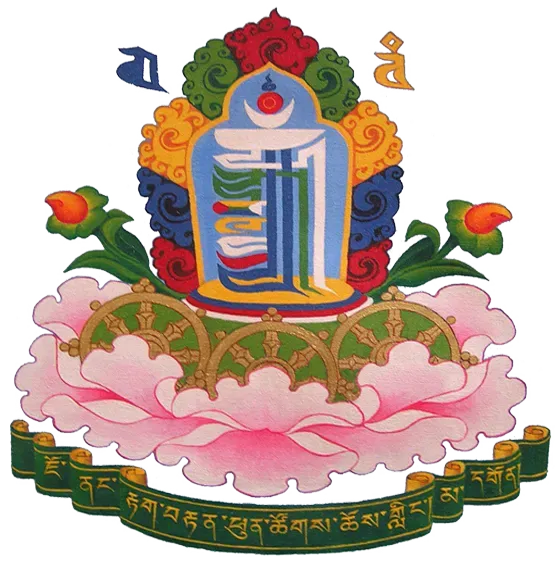Masters:
-tshul khrims snying po
-skyi ston ‘jam dbyangs
-byang chub seng+ge
-tshul khrims bzang po
-grags pa rgyal mtshan
-shes rab bzang po
-gzhon nu bzang po
-blo gros bstan pa
-bsod nams grags pa
-nag ‘bum
-Yonten Gyatso
-yon tan rgya mtsho
-Chokle Namgyel
Menchukhawa Lodro Gyeltsen (sman chu kha ba blo gros rgyal mtshan) was born in 1314 in Kyisho Tolung (skyid shod stod lung) in U. Up to the age of eight years he studied Tibetan opera, art, sculpture, and reading and writing. When he was thirteen years old he went to Sangpu Monastery (gsang phu), where he received ordination as a novice monk. He studied epistemology, the vehicle of the perfections, and the monastic code in various monasteries in U.
He traveled to the great monastery of Sakya (sa skya) in Tsang, where he studied subjects such as grammar, poetics, epistemology, abhidharma, the monastic code, and the Hevajra Tantra under the master Jigme Drakpa (‘jigs med grags pa, d.u.). He remained there for five years. During that time the Sakya master Jamyang Zhitokpa (‘jam dbyangs bzhi thog pa, d.u.) invited Dolpopa Sherab Gyeltsen (dol po pa shes rab rgyal tshan, 1292-1361) to teach at Sakya.
According to tradition, the evening before Dolpopa’s arrival, Lodro Gyeltsen had a dream of the tantric goddess Vajravārahī, who spoke to him:
An emanation of the Kalki,
the glorious Jonangpa,
the omniscient being
who has been your master
through many lifetimes,
is coming tomorrow.
My son, Lodro Gyeltsen Pel,
you must receive dharma from him!
Early the next morning about ten thousand men on horseback gathered, along with thousands of monks who lined the road holding incense, victory banners, and musical instruments. They welcomed Dolpopa to Sakya, inviting him to the Genden Temple (dga’ ldan gyi lha khang).
Lodro Gyeltsen received many teachings from Dolpopa, including the Kālacakra initiation, many Indian scriptures of the Kālacakra cycle, the Bodhisattva Trilogy, about a dozen different traditions of the six-branch yoga, and gained special experience and realization from the practice of these teachings. He also received many explanations of the Prajñāpāramitā, Madhyamaka philosophy, Chod (gcod), and the transmission of the Doha (do ha) instructions.
At the age of forty-eight, Lodro Gyeltsen received teachings from Dolpopa’s major disciple Kunpang Chodrak Pelzang (kun spangs chos grags dpal bzang, c.1283-1363), such as the Hevajra initiation, Lamdre, the Tantra Trilogy of Hevajra, and the great Vimalaprabhā commentary to the Kālacakra Tantra. He also requested the Bodhisattva Trilogy and many other teachings from Dolpopa’s major disciple Jonang Lotsāwa Lodro Pel (jo nang lo tsA wa blo gros dpal, 1299-1354).
He then studied with Dolpopa’s major disciple Chokle Namgyel (phyogs las rnam rgyal, 1306-1386), especially receiving many initiations from different traditions of Guhyasamāja and Cakrasaṃvara. In 1358 he also traveled with Chokle Namgyel to U, and, as they were returning to Tsang, Lodro Gyeltsen was offered the Menchu Hermitage (sman chu). Chokle Namgyel convinced him to accept the offer and stay in U to teach. It was from his association with this place that he earned his title, Menchukhawa.
One evening during a period when he was focused primarily on meditation practice, Menchukhawa is said to have had a dream of the buddha Maitreya on a white lion, surrounded by the sixteen arhats, and heard him speak the Five Treatises of Maitreya. The next morning the blowing of a conch shell was heard, and Dolpopa’s major disciple Mati Paṇchen Lodro Gyeltsen (ma ti paN chen blo gros rgyal mtshan, 1294-1376) arrived riding a white hybrid yak-cow, accompanied by sixteen monks. Menchukhawa thought this was an exceptional omen in accordance with his dream and felt that Mati Paṇchen was Maitreya himself. At Menchukhawa’s insistence, Mati Paṇchen stayed at Menchu hermitage for one month and taught the Five Treatises of Maiteya and many other subjects, such as the Five Stages (rim lnga) of the Guhyasamāja and of the Cakrasaṃvara traditions.
In 1369 the great Sakya master Lama Dampa Sonam Gyeltsen (bla ma dam pa bsod nams rgyal mtshan) came to teach at Nyetang (snye thang) in U. On that occasion some adherents to a nihilistic view (chad lta) proclaimed that there was no emptiness beyond an emptiness of self-nature (rang stong) and maintained that ultimate reality was an absolute void (gshis lugs la cang med). Menchukhawa arrived at Nyetang and, citing authentic scriptures as witnesses, debated with them for seven days in a great display of scriptural knowledge and reasoning, destroying all their bravado. At the end of these discussions, Lama Dampa, the master Tashi Sengge (bkra shis seng ge), Yakde Paṇchen Namkha Sonam (g.yag sde paN chen nam mkha’ bsod nams, d.u.), and other great experts are said to have bestowed many gifts upon Menchukhawa.
In 1370 Menchukhawa traveled to Babrim (‘bab rim), where he gave many teachings such as the Vimalaprabhā. In 1371 he returned to the hermitage of Menchu, and also taught at the Kagyu monastery of Drigung (‘bri gung) and other monasteries in U. In 1378 he heard that his friend Chokle Namgyel was again visiting the region. They met at Nyetang monastery and, at Chokle Namgyel‘s insistence, Menchukhawa taught in depth about Buddhist philosophical tenets.
Menchukhawa passed away at Menchu hermitage in 1389.
Bibliography
Gyal ba jo bzang dpal bzang po. 1992. Chos kyi rje kun mkhyen chen po yab sras bco lnga’i rnam thar nye bar bsdus pa ngo mtshar rab gsal. In The ‘Dzam-thang Edition of the Collected Works (Gsung-‘bum) of Kun-mkhyen Dol-po-pa Shes-rab rgyal-mtshan, Delhi: Shedrup Books, vol. 1: 559–629, pp. 605–611. The same work has also been published in Byang sems rgyal ba ye shes. 2004. Dpal ldan dus kyi ‘khor lo jo nang pa’i lugs kyi bla ma brgyud pa’i rnam thar. Beijing: Mi rigs dpe skrun khang, 2004, 143–209.
Ngag dbang blo gros grags pa. 1992. Dpal ldan jo nang pa’i chos ‘byung rgyal ba’i chos tshul gsal byed zla ba’i sgron me. Koko Nor: Krung go’i bod kyi shes rig dpe skrun khang, 1992, p. 35.



